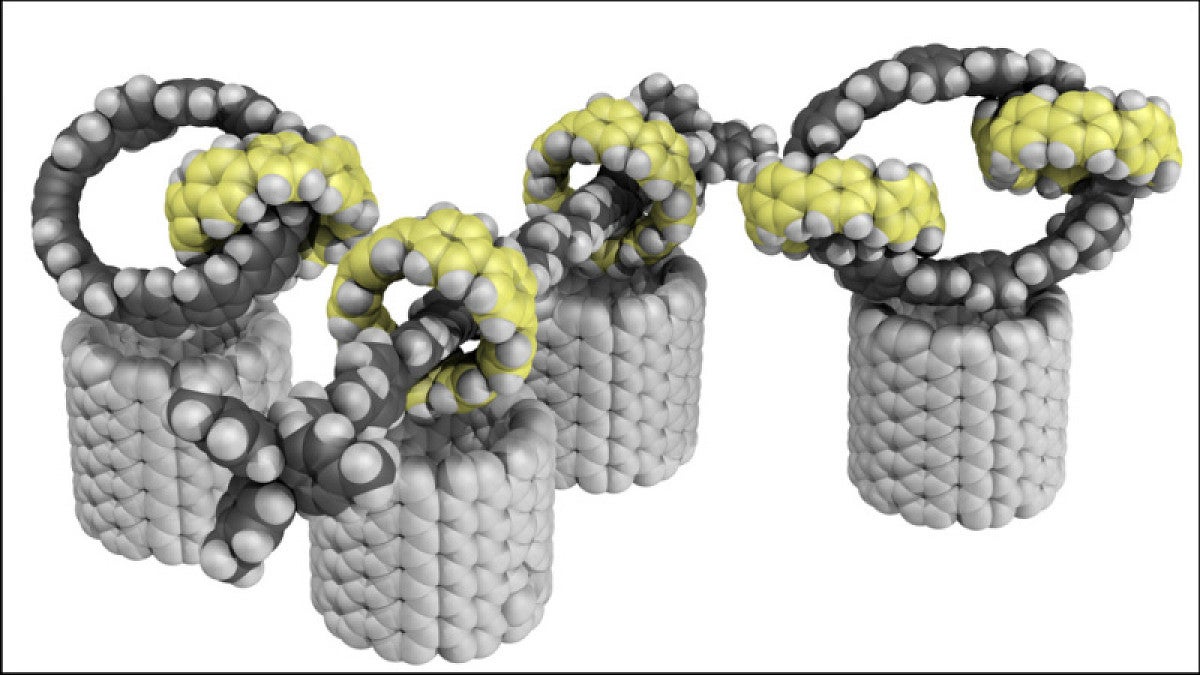Read the latest research from our department.

Active template strategy for the preparation of π-conjugated interlocked nanocarbons
James H. May, graduate student in the chemistry department
Ramesh Jasti, professor of chemistry
Chemists at the University of Oregon have discovered a new nanomaterial made from carbon-based molecules by using interlocking rings. This structure is potentially useful for a range of applications, such as specialized sensors and new types of electronics. The material is created by adding a metal atom to one ring, starting a chemical reaction to make a second ring, which is then trapped and locked together with the first. By making nanoscale adjustments to the material, scientists hope to create electronics or biomedical materials with novel properties.
Read the published research in Nature Journal and a story about May's work in Around the O.

Nanoscale semiconductor/catalyst interfaces in photoelectrochemistry
Shannon Boettcher, associate professor of chemistry and biochemistry, member of the Materials Science Institute
Researchers at the University of Oregon have discovered that shrinking the size of particles used as catalysts to below 100 nanometers can increase the efficiency of devices that use light to produce hydrogen from water. The discovery could lead to new design strategies for creating devices that use catalytic and semiconductor components to make hydrogen that can be stored for use when the sun is not shining.
Read the published research in Nature Journal and a story about Boettcher’s work in Around the O.

To split in two, stem cells harness the power of wrinkles
Ken Prehoda, professor of biochemistry
Bryce LaFoya, postdoctoral researcher
A dividing cell needs to maneuver its insides so that the right components will end up in each cell, to produce two functioning cells. University of Oregon biochemists are trying to solve a fundamental puzzle: how a dividing stem cell portions out its membrane during the process of division. In a new study, they show how ready-to-divide stem cells create a reservoir of extra membrane, which accommodates the increased surface area necessary for two cells.
Read the published research in Developmental Cell and a story about their work in Around the O.
Comparison of click-capable oxaliplatin and cisplatin derivatives to better understand Pt(II)-induced nucleolar stress
Andres Guerrero, graduate student
Hannah Pigg, graduate student
Katelyn Alley, graduate student
Victoria DeRose, professor of bioinorganic chemistry
Through NPM1 relocalization, fibrillarin redistribution, and γH2AX phosphorylation studies, University of Oregon researchers have identified key differences between previously studied click-capable cisplatin mimics and novel click-capable oxaliplatin mimics. These compounds provide new tools to identify cellular targets and localization through post-treatment Cu-catalyzed azide-alkyne cycloaddition and may help to better understand Pt(II)-induced nucleolar stress.
Read the published research in ChemRxiv.
Dynamics of protein droplets revealed by bridging multiple scales
Marina Guenza, professor of theoretical physical chemistry
Many biological processes rely on proteins that aggregate into droplets governed by dynamics that span myriad scales. Through a clever combination of spectroscopy and simulation, a University of Oregon researcher offers a way to probe these diverse dynamics.
Read the published research in Nature Journal.
In situ measurement of evolving excited-state dynamics during deposition and processing of organic films by single-shot transient absorption
Zachary S. Walbrun, graduate student
Cathy Y. Wong, assistant professor of chemistry and biochemistry
Researchers at the University of Oregon are exploring single-shot transient absorption, which measures a transient spectrum in a single shot, enabling the rapid measurement of unstable chemical systems such as organic films during their casting and processing. They review the principles of instrument design and provide examples of the utility of this spectroscopy for measuring organic films during their production.
Read the published research in Annual Review of Physical Chemistry.

